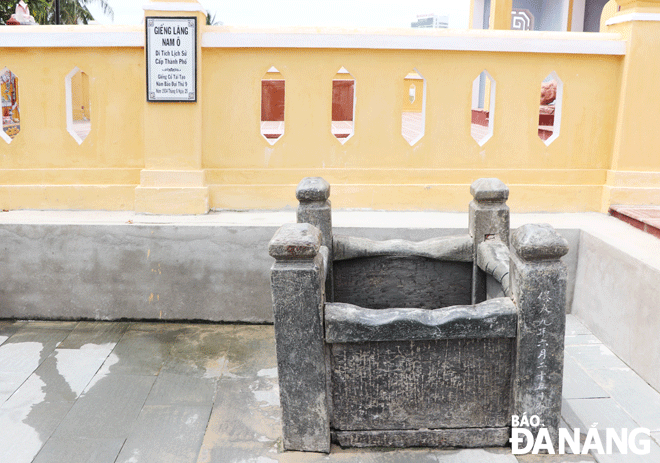Preserving ancient Cham wells in Da Nang
The existence of ancient Cham wells in Da Nang is the visual evidence showing the process of exchanging and mixing cultural flows in history. The technique of digging wells, finding pure water sources and the well system of the Cham people is a valuable cultural heritage. Not only does the conservation of these wells serve research, archaeology and learning about the ancient Cham culture, but it also contributes to the creation of landscapes and tourist destinations for the city.
 |
| Lang Well is located in the Nam O relic cluster in Hoa Hiep Nam Ward, Lien Chieu District. Photo: XUAN DUNG |
Preserving valuable traces of the past
According to the Cultural Heritage Management Department of Danang Museum, there are 7 well-preserved Cham wells distributed in Hai Chau, Cam Le, Lien Chieu and Hoa Vang districts. In general, the Cham wells in Da Nang are similar to those in other localities, which can be divided into 3 types: open well, semi-open well and closed well, the most common type located in residential areas. These Cham wells are usually square in shape and paved with bricks or stones depending on the local source of materials.
Cham wells have the special feature of having a clean water source, which is cool in summer and warm in winter. Over hundreds of years, the water in these wells has always been abundant and is sometimes used by people for spiritual activities of the village or for daily activities.
Among current Cham wells in Da Nang, there are 4 out of 7 wells located in the Nam O area, Lien Chieu District. Some researchers in the area surmise that before becoming Dai Viet territory and possibly after, Nam O was a rich, densely populated Cham village and its main occupation was fishing, making fish sauce and also trading fresh water for international merchant ships.
According to Mr Dang Dung, a Nam O native who has studied the culture of his village for many years, a special feature of Cham wells is that even in wells close to the sea, it also brings fresh water. For example, Lang well, the well located closest to the sea edge of all surveyed Cham wells in Vietnam, is only about 50m from the edge of the sea.
For the time being, this well is no longer used for daily life but the locals have always preserved it because it is still an important spiritual address of Nam O Village. This is also the place where people in the village often gather together to have some relaxing community activities.
Preserve and promote cultural values
As shared by Mr Dang Dung, with the characteristics of living in an area with harsh nature in the Central region of Viet Nam, finding freshwater underground circuits and having techniques for exploiting it to serve people’s lives were great skills of the ancient Cham people. The elders in the village recounted that the ancient Cham people found a source of water to dig a well by placing a piece of paper under the cup upside down and leaving it overnight.
If the paper under the cup is wet the next day, there is an underground water source. However, this method has not been confirmed yet, so if there is research to confirm it, it will contribute to broadening the understanding of Cham culture. In addition, it is necessary to take measures to preserve the Cham wells in the area to preserve this precious cultural heritage, to ensure solemnity as well as to serve for sightseeing, research or tourism.
Regarding the value of Cham wells, researcher Vo Van Thang, former director of the Museum of Cham Sculpture, said that the remaining ancient wells inDa Nang today show a continuation and cultural exchange between the two cultures Viet - Cham; At the same time, these are also bases for research, archeology and exploration of ancient Cham culture.
Currently, the technique of digging wells of the Cham people has been lost and there is no scientific study to explain it specifically. It has been all just word of mouth from previous generations. In addition, the fact that Cham wells are located near rivers and the sea but are not contaminated with salt or alum is also a big question for experts.
“To preserve Cham wells, management agencies should mark and identify these wells and promote propaganda to the people to mobilize the community's cooperation to protect the wells. At the same time, these wells can be turned into independent monuments for easy identification on the city's heritage map," said Mr Thang.
Recently, Da Nang has invested in the restoration of the Nam O relic cluster at a cost of over VND 25 billion, including preserving the original value of the Lang well for people to continue using. In the coming time, other ancient wells will also be restored and returned to their original state, creating a landscape to form a tourist destination, "said Mr Huynh Dinh Quoc Thien, the Director of Danang Museum.
7 Cham wells
Currently, there are 7 Cham wells in Da Nang, namely Hoi well, located at the corner of Ba Temple courtyard, in the Hoa Vang Hoa Vang cemetery in Khue Trung Ward, Cam Le District); Bong well, located on Trung Nu Vuong Street, Binh Hien Ward, Hai Chau District; Trung Son well, located in Trung Son forest relic cluster, Hoa Lien Commune, Hoa Vang District. The remaining 4 wells are located in Lien Chieu District, including Hoa O well which is also known as Ba Bang well, Dinh well, Lang well and Thanh Tram well, all located in Hoa Hiep Nam Ward.
Reporting by XUAN DUNG- Translating by T.VY